

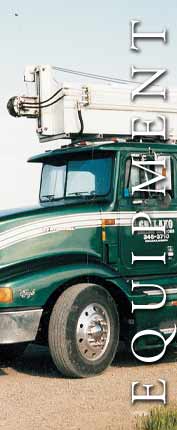
Other Equipment
Grouting equipment
all holes can be grouted when required. Grouting can be accomplished through hollow stem augers, or in an open hole.
Pressure Washer
a mobile pressure washer for cleaning of augers and sampling equipment is available.
Support Truck
for transport of supplies.
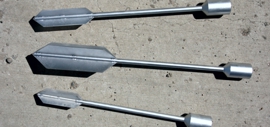

Vane Shear Testing
Chilako Drilling has Vane Shear testing equipment.
The vane shear test is an in-situ geotechnical testing method used to estimate the undrained shear strength of fully saturated clays without disturbance. The test is relatively simple, quick, and provides a cost-effective way of estimating the soil shear strength; therefore, it is widely used in geotechnical investigations.
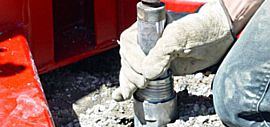

Direct Push Tooling
Direct Push Tooling Technology allows for a wide variety of direct push tooling and instrumentation to be advanced into a subsurface lithology using the static weight of the rig, hydraulic down pressure, and rapid hydraulic hammering.
Direct push tooling is designed for environmental sampling and monitoring of soil, soil gas, and groundwater. It is also used for remediation investigation and various geotechnical activities. Chilako Drilling has a direct push rapid hydraulic hammer mounted on a 4 wheel drive one ton B31 drill to facilitate direct push sampling.
The versatility of direct push tooling provides investigators with a variety of soil investigation options that are effective in sand, tight silt, swelling clay, and small gravels. Direct push tooling also minimizes surface and subsurface disturbance by creating only small diameter bore holes providing quick collection of samples from confirmation borings for site closure.
We would be happy to answer your questions about Direct Push Tooling!


Cone Penetration Testing
The basis for a solid foundation begins below the surface, so it is important to have a detailed and accurate evaluation of what lies beneath the surface at the actual construction site before developing the specifications for a construction project. While there are several types of in-situ geotechnical investigation techniques that can be performed to determine this, Cone Penetration Testing (CPT) is one of the most common and accepted methods worldwide.
Chilako Drilling provides this service with our CPT equipment, including standard Cone Penetration Testing and Seismic Cone Penetration Testing. Mounted on our trucks, we can generate such pushing forces that we can perform this test in most soil types, even in stiff to very stiff soils.
The test, which is standardized by ASTM D5778, consists of pushing an instrumented cone tip into the ground at a velocity of 2cm/second. The data is recorded and displayed immediately on site at regular intervals during the penetration test, producing a continuous, precision soil profile. This is a valuable on-site asset for engineers to facilitate decisions regarding geotechnical design. Moreover, since CPT data can be processed immediately at the site, engineers do not have to wait for reports which saves both time and money.
If you require any additional information about CPT, feel free to contact us.
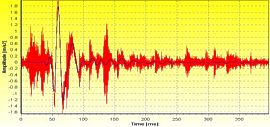

Seismic Cone Penetration Testing
Seismic Cone Penetration Testing (SCPT) has proven to be an incredibly valuable geotechnical tool in facilitating the determination of low strain in-situ compression and shear wave velocities. These velocities are directly related to the various soil elastic constants (Poisson's ratio, shear modulus, bulk modulus and Young's modulus). Another important use of estimated shear wave velocities is in the liquefaction assessment of soils.
An important factor in SCPT is the generation of clean, strong and reproducible seismic disturbances. The hammer beam method (applying a hammer blow laterally to the sides of special designed plates) generates excellent signals and is commonly used for SCPT.
The seismic CPT data acquisition is conducted with a seismic adapter, attached to a Cone Penetration Testing cone and designed such that the seismic sensors record the soil profile's response to low strain seismic disturbances. In accordance with ASTM D7400, this adapter is then pushed in the ground and readings are taken at 1m intervals until the soil layer of interest has been covered. The unfiltered readings are transferred to the surface to a Signal Conditioning System where the CPT data is separated from the seismic data. Next the seismic data is processed at the test site by data acquisition software to generate a data file that can be analyzed data reduction, analysis and visualization software to obtain the shear wave velocity profile as a function of depth.
The seismic cone has proven to be a cost effective, accurate and reliable tool in the determination of shear wave velocity profiles that we can now offer to our clients as input for their foundation design.
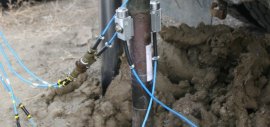

SPT Hammer Analysis
The Standard Penetration Test (SPT) is a widely used geotechnical test used to estimate soil strength. An SPT hammer drives a split barrel sampler at the bottom of a drive rod and recovers soil samples. The number of blows required to drive the last 300 mm is the "N value", and indicates soil strength. Several different types of SPT hammers are used to perform SPT tests, and this influences the N value. The American Society for Testing and Materials (ASTM) recommends standardizing the measured N value by multiplying it by the ratio between the measured energy transferred to the rod and 60% of the theoretical potential energy of the hammer. This compensates for widely variable efficiencies from different SPT hammer types and therefore improves the reliability of the estimates obtained from the test.
SPT Energy Calibration consists of measuring the energy transferred by the Standard Penetration Test (SPT) hammer to the SPT rod. Chilako Drilling take these measurements with the Pile Driving Analyzer® using an SPT rod instrumented with strain transducers and accelerometers.
The resulting analysis data is in accordance with ASTM D1586-08 Standard Test Method for Penetration Test and Split-Barrel Sampling of Soils, ASTM D4633-10 - Standard Test Method for Energy Measurement for Dynamic Penetrometers.
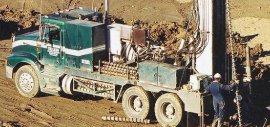

Auger Drilling
Solid and Hollow stem augers are the industry standard for geotechnical and environmental drilling. An auger bit is an excellent tool for penetrating most overburden formations found in the prairies of western Canada.
Drilling with solid stem augers is a quick and efficient method of obtaining soil samples and installing monitoring wells.
Hollow stem augers permit the installation of various types of soil samplers and installation of monitoring wells in sloughing conditions.
Auger sizes:
- 3-12" solid stem augers
- 2.75, 3.75, 4.25 and 6.25 inside diameter hollow stem augers
Chilako Drilling has many samplers including
- 2" SPT samplers
- 2.5" and 3.0" split barrel samplers
- 3.75" and 4.25" continuous samplers


Continuous Sampling with Hollow Stem Augers
Five foot long continuous samplers are part of the system that consistently recovers high quality samples in many augerable materials such as glacial till, hard clays and shales. The sealed bearing assembly conveys thrust during drilling to the tube and sampler shoe while isolating them from rotation of the center stem and augers.
The undisturbed soil sample enters the sample barrel as the augers are advanced. No drilling fluid or air is required.
Chilako Drilling has samplers for 3.75" and 4.25" hollow stem augers.


Down Hole Hammer (ODEX) and Overburden Casing
The under reaming bit is an integral part of an overburden system used in applications where the drilled hole may collapse when drilling with conventional methods.
The bit extends out further than the casing while in the drilling position. During the drilling operation, the bit drills a hole slightly larger than the casing diameter, and utilizing an internal drive shoe, allowing the bit and DTH hammer to drill and advance the casing simultaneously through unconsolidated formations and the effortless withdrawal of the bit after the casing has been set. Applications are typically in variable formations with soft layers overlying or interspersed with hard materials such as boulders or cobbles.
Chilako Drilling has Down Hole Hammers and casing advancing under reaming bits to drill 4.5" and 6.25" diameter holes to drill and install casing in unconsolidated rock formations of gravel, boulders and loose strata.
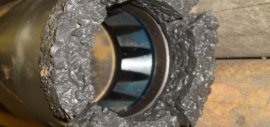

Wire Line Coring
In drilling with conventional equipment the entire drill sting with core barrel is required to be hoisted out of the bore hole after each three meter run to take the core sample out, and again lowered back with the drill string to start the next run. With wire-line drilling a core sample can be removed from the bottom of the hole without removing the drill rod string assembly.
When the driller wants to remove the core, an overshot is lowered on the end of a wire line. The overshot attaches to the back of the core barrel inner tube and the wire line is pulled back and the inner tube disengages itself from the barrel. In this process most of the time is available for drilling.
Wire-line coring is the solution when you require continuous core to be cut and retrieved over large intervals without tripping the drill string. It is also effective for quickly bringing core to surface to preserve it in a near natural state.
Chilako Drilling has HQ (2.5" core) and 4.625" (3.0" core) wire line core barrels.

